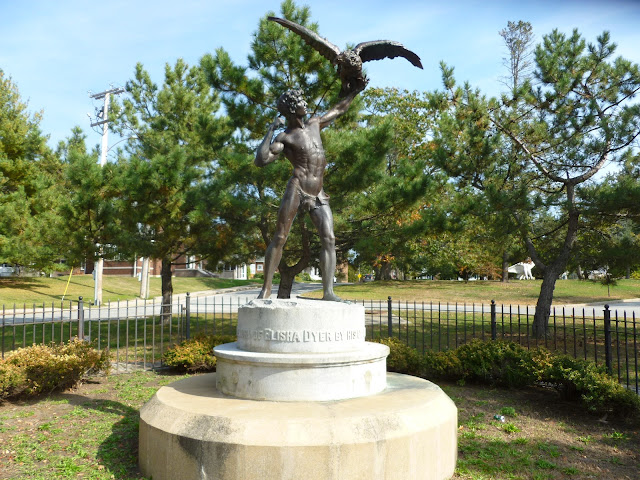Sri Chinmoy
Providence, RI
N 41° 46.427 W 071° 24.739
Short Description:
A statue of Indian spiritual leader, musician, poet, and peace activist Sri Chinmoy is located in Roger Williams Park between the south end of Elm Lake and Fredrick C. Green Memorial Blvd. in Providence, RI.
Long Description:
A life size bronze statue of Sri Chinmoy stands near the south shore of Elm Lake in Roger Williams Park. Chinmoy is wearing traditional Indian clothing of a tunic and sarong. He is holding the World Harmony Run Peace Torch in front of his chest with both hands. The statue was created by British sculptor Kaivalya Torpy and installed on April 8, 2011.
The bronze plinth is embedded in a on a 2' high by 3' square boulder. A bronze plaque in the boulder is inscribed:
Sri Chinmoy (1931 -2007)
Dreamer of Peace
Founder of the
World Harmony Run
18 April 2011
Chinmoy Kumar Ghose, better known as Sri Chinmoy, was born in British India, now Bangladesh, on August 27, 1931. He was an accomplished author, artist, poet, musician and spiritual leader. He moved to New York City in 1964 and established meditation centers, eventually attracting over 7,000 students in 60 countries.
Chinmoy became an skilled musician and composer with the flute and in 1984 began performing free peace concerts which were attended by many thousands of people around the world. He has created music with many instruments including: a variety of flutes, the Indian esraj, cello, harmonium, piano and pipe organ. Over his lifetime he has recorded over 17,000 songs. Currently his music is available for free streaming on the Radio Sir Chinmoy website as well as on Spotify, iHeart Radio, You Tube, and several other music sites.
Compact Disc Discography for Sri Chinmoy
Songs Of Eternity - 1972
My Pilot Supreme - 1972
My Flute : The Poetry and Teachings and Philosophy of Sri Chinmoy ?1972
Music For Meditation - 1976
Meditation-Sun - 1977
Aspiration-Delight - 1978
Meditation - Sea - 1979
Flute-Music For Meditation - 1983
Flowers Of Beauty And Delight - 1984
ExistencE-ConsciousnesS-Bliss - 1984
The Dance Of Light - 1986
Sri Chinmoy / Baoul Scavullo - 1990
Concert De Paix - 1992
Rupali & Anuraga, Sri Chinmoy - Flame Worlds - 1994
Temple-Song-Hearts - Unknown
Mountain Silence Music By Sri Chinmoy - Gratitude-Flower-Hearts - Unknown
Singles & EPs
My Heart-Garden-Songs - 1989
Chinmoy has written over 120,000 poems, mostly short but complete spiritual poem or verse. He has also published several volume of longer, poems in the more classical style. Volumes include:
Seventy-Seven Thousand Service-Trees,
Twenty-Seven Thousand Aspiration-Plants,
Ten Thousand Flower-Flames,
The Dance of Life,
Wings of Light and
My Christmas-New Year-Vacation-Aspiration-Prayers.
Chinmoy has recited his poetry at the United Nations as part of a UN sponsored event of promoting Dialogue Among Civilizations Through Poetry. Three of Chinmoy's poems on the theme of hope were recited by at a ceremony to mark the 9th anniversary of the 9/11 attack on the World Trade Center.



















































